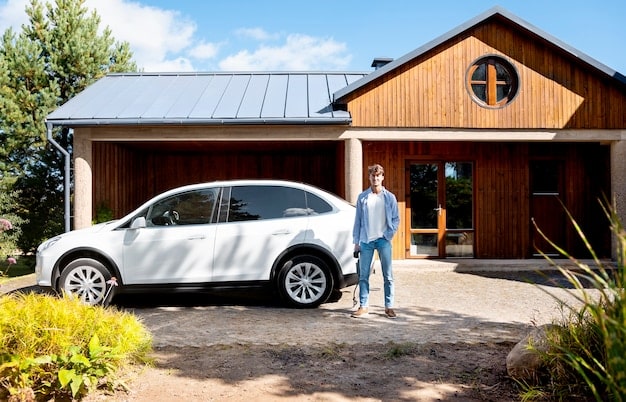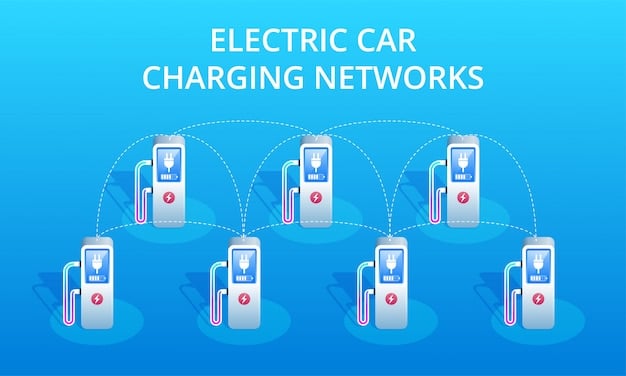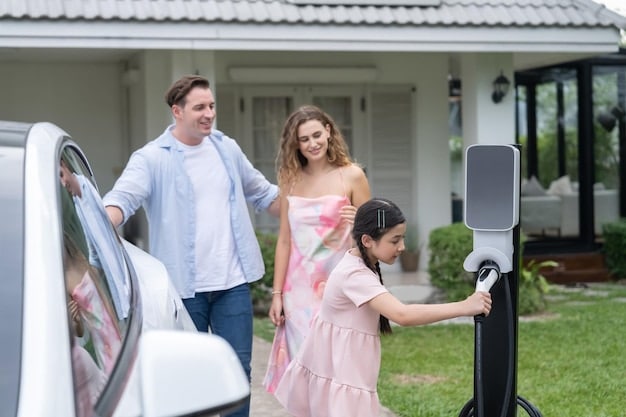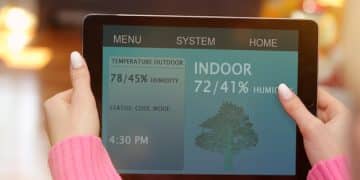Smart Home & EV Integration: Will Bidirectional Charging Be Standard by 2025?

Smart home integration with electric vehicles (EVs) is revolutionizing energy consumption, and bidirectional charging, allowing EVs to both draw and supply power, may become standard by 2025, enhancing grid stability and reducing energy costs for homeowners.
The convergence of smart home technology and electric vehicles is creating exciting new possibilities for energy management. Smart Home Integration with Electric Vehicles: Will Bidirectional Charging Become Standard by 2025? Imagine your EV not just as a mode of transportation, but as a mobile energy storage unit that can power your home and even feed energy back into the grid.
The Rise of Smart Home Energy Management
Smart home energy management systems are gaining traction as homeowners seek greater control over their energy consumption and costs. These systems leverage data and automation to optimize energy usage, reduce waste, and integrate renewable energy sources.
Key Components of Smart Home Energy Management
Several key components work together to create a comprehensive smart home energy management system. These components include smart thermostats, smart lighting, smart appliances, and energy monitoring tools.
Benefits of Smart Home Energy Management
Smart home energy management offers a range of benefits, from reduced energy bills to increased comfort and convenience. By automating energy usage and providing real-time insights, these systems empower homeowners to make informed decisions about their energy consumption.
- Cost Savings: Reduced energy consumption leads to lower monthly bills.
- Increased Comfort: Automated adjustments to temperature and lighting based on occupancy and preferences.
- Environmental Benefits: Reduced reliance on fossil fuels and lowered carbon footprint.
- Convenience: Remote control and monitoring of energy usage via smartphone or tablet.
As technology advances and energy costs continue to rise, smart home energy management will become increasingly essential for homeowners looking to optimize their energy consumption and embrace sustainability.
Electric Vehicles: More Than Just Transportation
Electric vehicles are rapidly transforming the automotive industry and redefining the way we think about transportation. EVs offer a cleaner, more efficient alternative to traditional gasoline-powered cars, and their integration with smart home technology is unlocking even greater potential.
The Growing Popularity of EVs
The popularity of EVs is surging, driven by factors such as increasing environmental awareness, government incentives, and advancements in battery technology. As EVs become more affordable and accessible, they are poised to become a mainstream mode of transportation.
EV Batteries as Mobile Energy Storage
One of the most exciting aspects of EVs is their potential to serve as mobile energy storage units. EV batteries can store significant amounts of energy, which can be used to power homes, businesses, or even the grid in certain scenarios.
The ability to use EV batteries for energy storage opens up a world of possibilities, from reducing reliance on the grid to providing backup power during outages. As bidirectional charging technology matures, EVs will play an increasingly important role in the energy ecosystem.

Bidirectional Charging: The Game Changer
Bidirectional charging is a revolutionary technology that allows electric vehicles to not only draw power from the grid but also supply power back to it. This capability has the potential to transform the energy landscape and create a more resilient and sustainable grid.
Vehicle-to-Grid (V2G) Technology
Vehicle-to-grid (V2G) technology is a key component of bidirectional charging. V2G systems enable EVs to communicate with the grid and provide services such as frequency regulation and peak shaving.
How Bidirectional Charging Works
Bidirectional charging works by using specialized charging equipment that can convert DC power from the EV battery into AC power that can be used by the home or fed back into the grid. This process requires sophisticated control systems and communication protocols to ensure safety and efficiency.
The technical specifications for bidirectional charging are still evolving, but several international standards are under development to ensure interoperability and safety. As these standards are finalized, bidirectional charging is expected to become more widespread.
The Benefits of Bidirectional Charging in a Smart Home
Integrating bidirectional charging into a smart home offers a multitude of benefits for homeowners, including reduced energy costs, increased energy resilience, and a lower carbon footprint.
Reducing Energy Costs
Bidirectional charging can significantly reduce energy costs by allowing homeowners to use their EV battery to power their home during peak demand periods, when electricity prices are typically higher. This can also help to reduce strain on the grid and prevent blackouts.
Enhancing Energy Resilience
In the event of a power outage, an EV with bidirectional charging capability can provide backup power to the home, keeping essential appliances running and ensuring continuity of service. This is particularly valuable for homeowners who rely on medical equipment or who live in areas prone to power outages.
Bidirectional charging can also enhance energy resilience by enabling homes to operate independently from the grid for extended periods, particularly when combined with solar panels and battery storage.
- Emergency Backup: Provides power during grid outages.
- Peak Shaving: Reduces energy consumption during high-demand periods.
- Grid Stabilization: Supports grid frequency regulation.
- Cost Optimization: Enables arbitrage by charging during off-peak hours and discharging during peak hours.
By leveraging the energy storage capacity of EVs, bidirectional charging can create a more resilient and sustainable energy system for homeowners and communities.

Challenges and Opportunities for Widespread Adoption
While bidirectional charging holds immense promise, several challenges must be addressed to enable its widespread adoption. These challenges include technical standardization, grid infrastructure upgrades, and regulatory hurdles.
Technical Standardization and Interoperability
One of the key challenges is the lack of standardized protocols and equipment for bidirectional charging. To ensure interoperability between different EV models and charging systems, industry-wide standards are needed.
Grid Infrastructure Upgrades
The existing grid infrastructure may not be able to handle the influx of energy from EVs discharging back into the grid. Upgrades to transformers, distribution lines, and control systems may be necessary to accommodate bidirectional charging on a large scale.
Investment in smart grid technologies, such as advanced metering infrastructure (AMI) and distributed energy resource management systems (DERMS), will also be crucial to managing the two-way flow of energy between EVs and the grid.
Looking Ahead: The Future of Smart Home and EV Integration
The integration of smart home technology and electric vehicles is poised to revolutionize the way we consume and manage energy. As bidirectional charging technology matures and becomes more affordable, it is likely to become a standard feature in EVs and smart homes.
Predictions for 2025 and Beyond
By 2025, we can expect to see more EVs equipped with bidirectional charging capabilities, as well as a wider range of smart home energy management systems that can seamlessly integrate with EVs. Government incentives and regulations will also play a key role in accelerating the adoption of bidirectional charging.
The Role of Policy and Incentives
Governments can encourage the adoption of bidirectional charging by offering tax credits, rebates, and other incentives to homeowners and businesses that invest in the technology. Clear regulatory frameworks are also needed to address issues such as grid interconnection and energy metering.
Collaboration between automakers, utilities, and technology companies will be essential to overcome the challenges and unlock the full potential of smart home and EV integration. By working together, these stakeholders can create a more sustainable and resilient energy future.
| Key Aspect | Brief Description |
|---|---|
| 💡 Bidirectional Charging | EVs supply power back to the grid or home. |
| ⚡ V2G Technology | Enables EVs to communicate and support the grid. |
| 💰 Cost Savings | Reduce energy bills by using EV battery during peak hours. |
| 🛡️ Energy Resilience | Backup power for homes during outages. |
Frequently Asked Questions (FAQ)
▼
Bidirectional charging allows electric vehicles to not only draw power from the grid but also supply it back, enabling EVs to act as mobile energy storage units for homes or the grid.
▼
V2G (Vehicle-to-Grid) technology enables EVs to communicate with the grid, providing services like frequency regulation by adjusting power flow based on grid needs, enhancing stability.
▼
EVs can significantly cut energy costs by powering homes during peak hours and acting as emergency backup during outages, thus enhancing energy resilience and reducing dependence on the grid.
▼
Key challenges include the need for standardized equipment and protocols, upgrades to grid infrastructure, and regulatory frameworks that accommodate the two-way flow of energy from EVs.
▼
The integration of EVs and smart homes will revolutionize energy consumption, with wider adoption of bidirectional charging, enhanced energy resilience, and smarter, interconnected energy systems in homes.
Conclusion
As we look to the future, the integration of smart home technology and electric vehicles holds tremendous potential for creating a more sustainable and resilient energy system. Bidirectional charging, in particular, is poised to play a key role in this transformation, enabling EVs to become active participants in the energy ecosystem and empowering homeowners to take control of their energy consumption.





